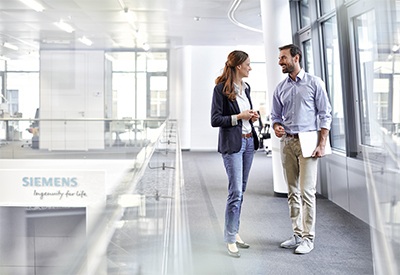Siemens Aims to Transform Buildings from Passive to Adaptive at Light+Building

Feb 13, 2020
At this year’s Light+Building trade fair, Siemens will showcase its vision for transforming today’s passive buildings into learning and adaptive environments that intelligently interact with people. The company’s focus at this year’s show is “Building the future today”, outlining the innovations that will make this possible. These include cloud-based technologies, digital planning, occupant-centric building automation and services. New solutions for smart electrical infrastructure that seamlessly connects to the Internet of Things (IoT) are also at the core of this transformation.
“Around 99 percent of today’s buildings are not smart. Digitalization has the power to transform buildings from silent and passive structures into living organisms that interact, learn from and adapt to the changing needs of occupants. This is a significant leap in the evolution of buildings where our technology plays a vital role,” said Cedrik Neike, Member of the Managing Board of Siemens AG and Chief Executive Officer of Siemens Smart Infrastructure. “This transformation is already becoming a reality. We expect to see the first entirely self-adaptive buildings in three to five years from now.”
Digital solutions for the entire building lifecycle
Globalization, urbanization, climate change, and demographics are changing the way people live and work. At the same time, digitalization is ubiquitous. With some 10 billion building devices already connected to the IoT, buildings are ready to leverage the potential of digitalization. People spend an estimated 90 percent of their lives indoors, so ensuring buildings meet the broad range of individuals’ needs is crucial. On one hand, smart buildings actively contribute to occupants’ enhanced productivity, wellbeing and comfort. For operators and owners, they help them collect and analyze data to create actionable insights, boosting buildings’ performance and therefore revenue.
Siemens will showcase the smart buildings suite of IoT enabled devices, applications and services. At the core of the suite is the “Building Twin” application, which will be on display at the booth. It provides a fully digital representation of a physical building, merging static as well as dynamic data from multiple sources into a 3D virtual model. With real-time understanding of how a building is performing, operators can immediately make adjustments to boost efficiency as well as extract data to improve the design of future buildings. One of the new IoT-enabled applications is “Building Operator”, which allows remote monitoring, operation and maintenance of buildings. Available as Software as a Service (SaaS), it provides real-time building data as the basis for predictive and corrective maintenance.
Smart electrical infrastructure
Given that buildings account for more than 40 percent of electricity consumption in cities, building efficiency is crucial in the battle towards decarbonization. Electrical infrastructure lays the foundation for safe, reliable and efficient building operations, while delivering essential data for a holistic, cloud-based building management. This is made possible by communication-capable low-voltage products, power distribution boards and busbar trunking systems that enable the measurement and wireless transmission of energy and status data.
To illustrate this, Siemens will exhibit a unique end-to-end solution for cloud-based power monitoring in buildings. Electrical installations can now be supplemented with digital metering without additional space requirements or wiring outlay. This makes it easy for electrical installers to start using digitalization to their benefit. With “Powermanager”, a power monitoring software, now fully integrated into the Desigo CC building management platform, all building and energy data can be managed, monitored and analyzed from one single platform.
Siemens will also display its electromobility ecosystem, including battery storage and charging systems for residential buildings.
Go HERE for more information on Siemens Smart Infrastructure
Go HERE for more information on Siemens at Light+Building









![Guide to the Canadian Electrical Code, Part 1[i] – A Road Map: Section 52 — Diagnostic imaging installations](https://electricalindustry.ca/wp-content/uploads/2022/11/Guide-CE-Code-2.png)






